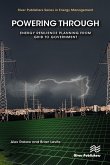The threats to the electricity grid are on the rise at the same time as society is increasing its dependence on electricity for every aspect of our personal, social, and economic lives. We are accelerating that dependence - looking to the electrification of transportation and buildings as a way to stem the threats of climate change. Those threats have now arrived (in the form of more extreme weather, droughts, and wildfire) and they are joined by increasing threats from an aging grid and cyberattacks. The grid we rely on is experiencing increasingly vulnerable external forces.We aren't helpless. Effective planning around these threats can dramatically reduce the havoc they engender on the electric grid. At every level, from a single building, to a city, to the electric grid and the federal government, steps can be taken to improve our resilience to threats to the electricity system. When those efforts are coordinated, their benefits multiply. This book aims to provide every level of decision-maker with tools and best practices for reducing the risk of and from electricity loss. It is written in non-technical language, with a focus on actionable, easily implemented steps.
Dieser Download kann aus rechtlichen Gründen nur mit Rechnungsadresse in A, B, BG, CY, CZ, D, DK, EW, E, FIN, F, GR, HR, H, IRL, I, LT, L, LR, M, NL, PL, P, R, S, SLO, SK ausgeliefert werden.









